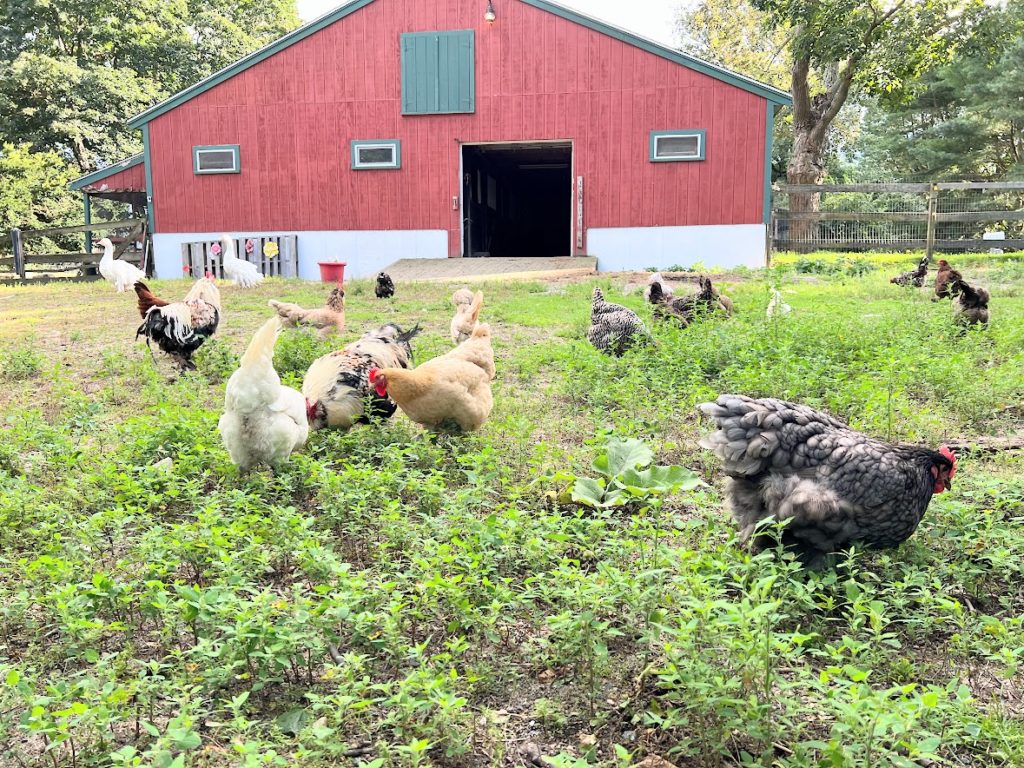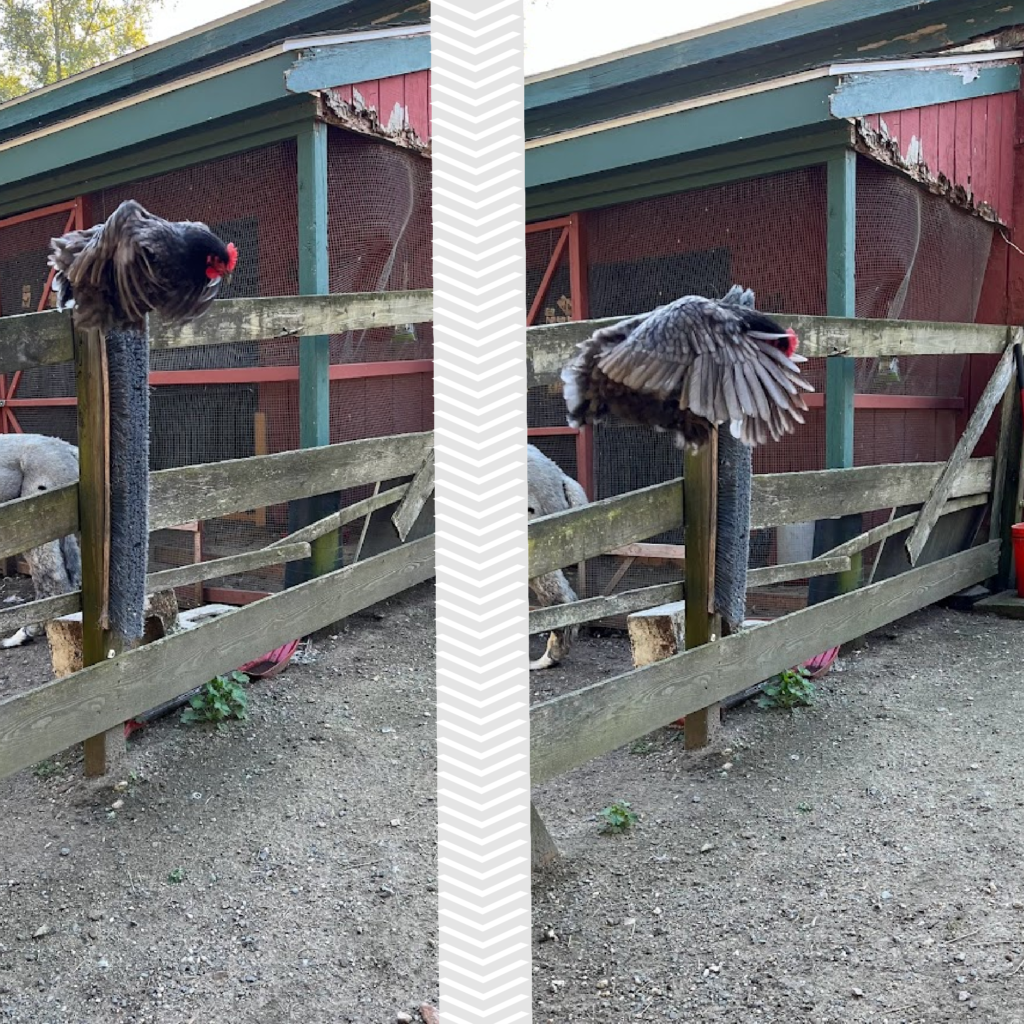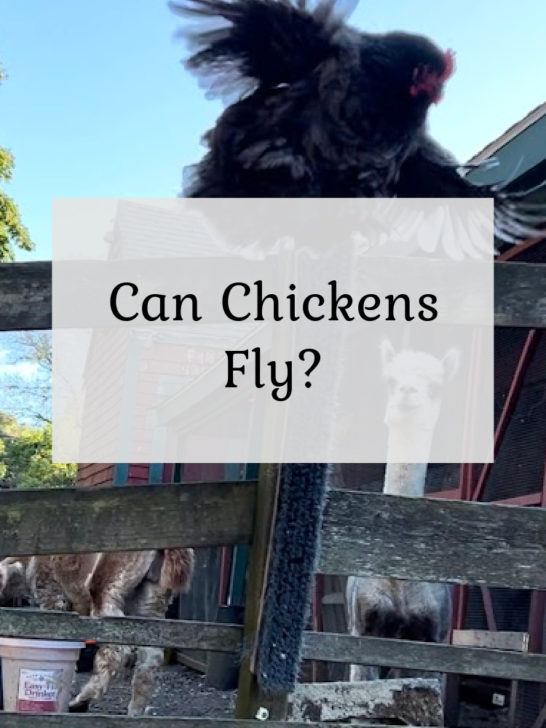---------------------------------------------------------
Can chickens fly? Many new chicken keepers are worried about their new bird friends flying away. Luckily, domesticated chickens as we know them today can’t fly like other birds.
Chicken ancestors
Chickens have been domesticated for over 8,000 years. In all those years, humans have selectively bred chickens to be heavier so they would have more meat. They also bred for shorter wingspans so they can’t fly away from farms. They might not be able to soar in the sky or fly south for the winter, but chickens can fly a little bit.
The chicken’s closest wild ancestor is thought to be the red junglefowl native to southeast Asia. The red junglefowl is significantly smaller (about 2-3 pounds vs 7-10 pounds for a standard breed chicken). Junglefowl can fly short distances but is still primarily a ground-foraging bird that relies more on thick brush cover and camouflage to avoid predators.

How far can a chicken fly?
With their heavy bodies and their short wings chickens are not great fliers. I would say they are gliders more than fliers.
Lifting off from the ground like other birds is difficult for chickens. But if they hop up on a roost, bush, or fence they can take off and glide for 30-50 feet. With a running start, many chickens can get 3-4 feet high taking off from the ground to reach a low branch or fence top. Small breed chickens might even be able to get 8-10 feet off the ground.
This means in theory some chickens will be able to escape over a standard 6-foot privacy fence. In practice, most chickens enjoy the free treats and safe shelter that comes from living with humans. They are unlikely to leave their flock and food behind unless they are chased by a predator or are extra curious.
Which chicken breeds can fly?
Smaller bantam breed chickens have the best chance at flying and could definitely escape over a 4 foot fence if motivated. Of the standard-size chicken breeds, the leaner and more muscular the chicken, the more likely they are to fly. Some breeds known to be escape artists include Araucana, Easter Eggers, Yokohamas, Spitzhaubens, and Leghorns. Young chickens that are not yet fully grown are also good fliers. You should keep a close eye on pullets and roos under 18 weeks because these little guys can fly surprisingly high!
The majority of the chickens I have raised are standard size, in dozens of different breeds. I have never had one fly over a 6-foot fence, but I have had a few Easter Eggers that could get over a 4 foot fence. While breed and size play a part in chickens escaping their yard, sometimes personality is just as important. Some birds are just more adventurous! They are more likely to try and fly over a fence if they can see the other side (like a chain link or picket fence). A solid privacy fence gives them little incentive to test their luck on the other side.

What chicken breeds can’t fly?
It’s not surprising that the super heavy breeds like Wyandottes, Cochins, Orpingtons, and Brahmas live most of their lives on the ground. These big guys can realistically only get a foot or two in the air for very short distances.
Silkies are typically a bantam or very small standard size chicken. Even though they are small their odd fur like feathers do not support flight at all. Likewise, Frizzles with their curly feathers can not fly at all.
Clipping a chicken’s wings
The good news is that if you have a chicken escape, they are unlikely to go far. But if you have close neighbors, lots of predators, or live near a busy road, a loose chicken can be in danger or could ruin your neighbor’s landscaping. Seeing one member of the flock escape might also encourage others to fly out to join her.
Clipping a chicken’s wing is a really easy process. It does not hurt them at all, it is just like a haircut. Most of the time it is only necessary to clip one wing. This puts the chicken off balance and makes take-off shakey and unstable. A few chickens are super determined to explore the world and those chickens might need both wings clipped.
When clipping the wing, you only need to trim the primary flight feathers. These full-grown feathers should have hollow quills, with no nerves or blood supply. It is important that you avoid trimming any new feathers or pin feathers as these can bleed when trimmed.
When you extend your chicken’s wing, the primary flight feathers are the really long ones towards the front of the wing. Simply take some sharp scissors and trim! When the chicken tucks their wing back in you can’t even see they have been trimmed.
Clipping your chicken’s wings is not a permanent solution, however. When your chicken molts in the fall they will regrow new flight feathers. Some chickens will only need their wing clipped once though. They get used to being grounded and might not need you to retrim their flight feathers.








Paul
Tuesday 12th of September 2023
Yes, chickens can fly. I have seen feral chickens roosting in trees 100 feet up. I have seen them fly over 500 yards at an average of 15 to 25 feet off the ground. And not just bantams, full sized breeds like Wyandotte, Orpington, and Brahma fly just fine.
While most non feral chickens don’t exercise their wings the same way that feral and free range chickens do, in a pinch most can manage a decent flight as long as their wings are not clipped.
I have always free ranged my chickens, and I prefer to not clip any wings. Chickens with full wings have a better chance of escaping both aerial and ground predators, and making it to the safety of cover. Roosters with full wings can fight those predators and use their spurs to inflict some serious damage.
A 6 foot fence is a joke, 10 feet is much better. Various situations have different restrictions, but the perimeter fence is by far the most critical piece of infrastructure for anyone with livestock. If you have small livestock and aerial predators, having some places with overhead netting can be worth its weight in gold.
Chickens are little dinosaurs, and can rid your property of the vast majority of pests (if you let them, and teach them which pests are food). Chickens absolutely love eating rodents. They are far better mousers than any cat could ever dream of becoming.
Use common sense, do your best to give them what they need, and you will be happy with happy chickens. Not everyone has the space or conditions to give chickens what they need and want. Does that mean you shouldn’t raise chickens? Yes… Yes, that is exactly what it means. Stick to farming worms or something. Don’t raise any animal unless you can give it what it needs to be happy, including proper protection and enough companion friends to feel comfortable.
If you haven’t given any animal an incredibly good life, you don’t deserve to take it. .. That is the golden rule of stewardship. I get really pissed off when I see livestock that do not have immediate access to shade and water… Seriously pissed off. There are a lot of bad stewards in the world, but that is no excuse for you to be one of those d-bags as well… A wonderful life is the fair trade for a shortened life.
Liz
Wednesday 13th of September 2023
Wow! I have never seen any of my chickens even attempt flights of those distances! I have free ranged my birds for over 10 years and don't clip their wings. I've never had one make it over a 6 foot fence and only a few that could make it over a 4 foot. I raise mostly big, winter hardy breeds for my climate and the majority of them live their whole lives no more than a couple of feet off the ground. But they are fed, happy, and safe here so they don't have much motivation to leave. I'm sure if they were feral and left to fend for themselves they would have to adapt or die. For the vast majority of people keeping domesticated chickens in their backyard, standard 6 foot fencing will contain them unless they are neglected or being chased by predators.